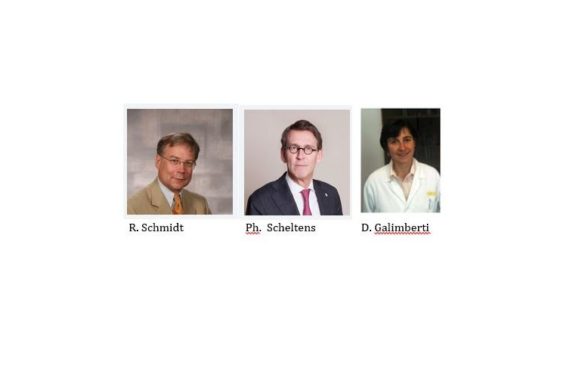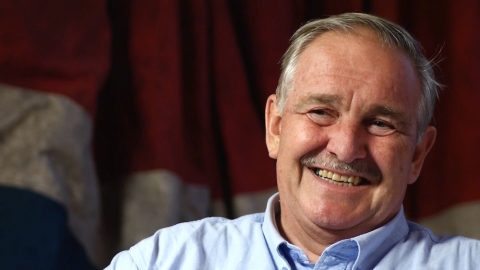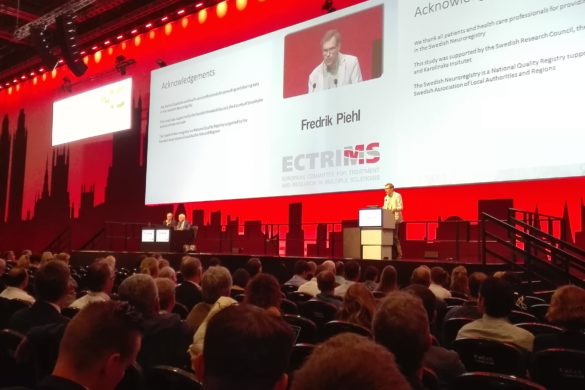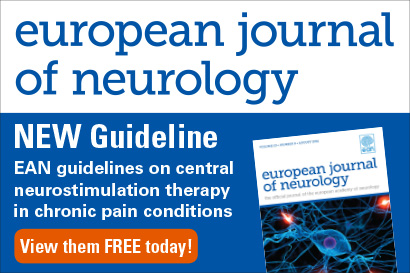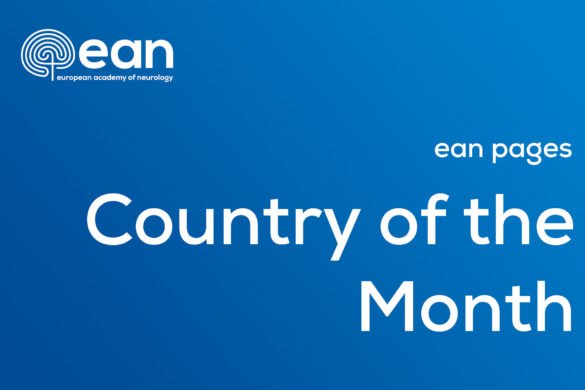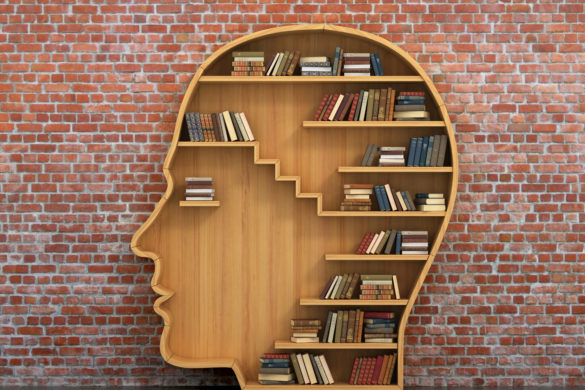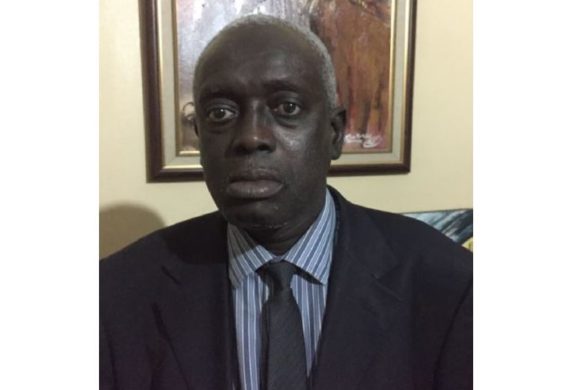Healthcare professionals’ working party elects co-chair
The European Medicines Agency’s (EMA) Healthcare Professionals’ Working Party (HCPWP) has re-elected Prof. Gonzalo Calvo as its co-chair at the September 2016 meeting.
Prof. M. de Visser, EAN Treasurer, is the EAN delegate to… Continue Reading
Author
Editor
-
-
Scientific panels reports
Scientific Panel on Palliative Care: Guidelines on palliative care in multiple sclerosis
October 1, 2016A Guideline Group is starting to look at the palliative care for people with multiple sclerosis. Dr Alessandra Solari, from Milan, has been leading an international group, including both neurologists and palliative care specialists. There will also be collaboration with… Continue Reading -
Executive PageEAN News
Treatment of neurodegenerative diseases: are we close to a breakthrough?
October 1, 2016It is a dream of neurologists to cure degenerative diseases. The big brothers, Alzheimers’ and Parkinsons’ disease have always been a huge burden of the population but are now, in the millennium of increasing population age becoming a scourge of humanity. While everybody is acknowledging this, both PD1 and AD2 communities of clinician researchers and basic researchers are preparing to attack the problem fundamentally frequently unnoticed by the general neurology community. -
Paper of the MonthFeatured Slider
Paper of the month and Scientific Debate: A new hope for Alzheimer’s disease treatment with the PRIME study?
October 1, 2016For October 2016 we have selected: Sevigny J, Chiao P, Bussiere T, et al. The antibody aducanumab reduces Aβ plaques in Alzheimer’s disease. Nature 2016;537:50-56. Alzheimer’s disease (AD) is the most frequent neurodegenerative disorder. It is also extremely disabling with severe impact of the quality of life of patients and caregivers. The main pathological process is related to the toxic deposition of amyloid-β plaques and neurofibrillary tangles. No effective treatment is currently available to slow down the disease progression. -
Scientific CornerFeatured Slider
A ROUND TABLE discussion of the Paper of the Month with the EAN SCIENTIFIC PANEL on DEMENTIA AND COGNITIVE DISORDERS
October 1, 2016EANpages has the honor and the pleasure to introduce this virtual Round Table, composed by some members of the EAN Scientific Panel on Dementia and Cognitive Disorders, who are discussing the Paper of the Month, in addition to the comments of the Presidential Page. We thank the Panel for their enthusiastic participation and we invite all EAN members to participate with sending their comments. -
InterviewsFeatured Slider
Interview with Prof. David Nutt – President of the European Brain Council (EBC)
October 1, 2016David B. Vodušek (DV): EFNS has been a founding member of EBC, and its successor EAN continues to be an actively involved member society. Nevertheless, many of our readers would appreciate to hear your views on what is EBC, its mission and how it gets this accomplished? David Nutt (DN): The ultimate reason behind all EBC actions is to improve the condition of those living with brain disorders and to reduce prevalence of brain diseases all together. -
By Jose E. Martínez-Rodríguez

More than 9000 participants attended the 32nd Congress of the European Committee for the Treatment and Research in Multiple Sclerosis (ECTRIMS) and the 21st Annual Conference of Rehabilitation in MS in London from September 14th to17th.… Continue Reading -
Eur J Neurol
New EAN guidelines on central neurostimulation therapy for chronic pain
September 29, 2016Cruccu G, Garcia-Larrea L, Hansson P, Keindl M, Lefaucheur JP, Paulus W, Taylor R, Tronnier V, Truini A, Attal N. EAN guidelines on central neurostimulation therapy in chronic pain conditions. Eur J Neurol. 2016 Aug 11. Why these guidelines ?… Continue Reading -
Georgia (Georgian: საქართველო, Sakartvelo) is a country located at the intersection of Eastern Europe and West Asia, and generally considered to be part of the European continent. To the west it is bordered by the Black Sea, to the north and northeast by Russia, to the south by Turkey and Armenia, and by Azerbaijan to the southeast.
-
Paper of the Month
Paper of the month: Percutaneous closure of patent foramen ovale does not reduce migraine duration
September 1, 2016For September 2016 we have selected: Mattle HP, Evers S, Hildick-Smith D, et al. Percutaneous closure of patent foramen ovale in migraine with aura, a randomized controlled trial. Eur Heart J 2016:37;2029-2036. There are about 50 million people suffering from migraine in Europe. About one third of the cases has migraine with aura, that has been found more prevalent in patients with patent foramen ovale (PFO). -
InterviewsFeatured Slider
Interview with Prof. Mansour Ndiaye President AFAN – African Academy of Neurology
September 1, 2016David Vodušek (DV): The AFAN, like the EAN, addresses and covers the neurological interest of a continent. Can you explain to the readers of the EANpages how was the AFAN created and why? Mansour Ndiaye (MN): Delegates from over 30 countries in Africa representing the interests of their national neurologic societies and associations met in Dakar, Senegal, over the weekend of August 29-30, 2015. -
See the Latest Reviews – FREE for limited period
-
The new CME article September 2016: Outcome of heparin-treated patients with acute cerebral venous sinus thrombosis: influence of the temporal pattern of intracerebral haemorrhage. Busch M.A. et al.“ is online now! Please log-in and browse to the LEARN section on… Continue Reading
-
Report from Dr Riccardo Galbusera from Freiburg, Germany visiting the Ofxord University Department of Clinical Neurosciences, West Wing, John Radcliffe Hospital, OX3 9DU Oxford, UK under the supervision of Prof. Martin Turner.
-
Resident and Research Fellows
Young Neurologists, Neurosurgeons and Neurophysiologists (YNNN)
September 1, 2016What is the YNNN? The association of Young Neurologists, Neurosurgeons and Neurophysiologists (YNNN) was founded in the 1970’ies in Denmark. The YNNN was formed from the Danish associations of Neurology (DNS), Neurosurgery (DNKS) and Clinical Neurophysiology (DSKN), but it is an independent association. It started with small meetings in basements, but in the last 10 years the association has grown into a nation-wide organization with about 350 members, and the annually joint meeting gathers more than 100 members.



